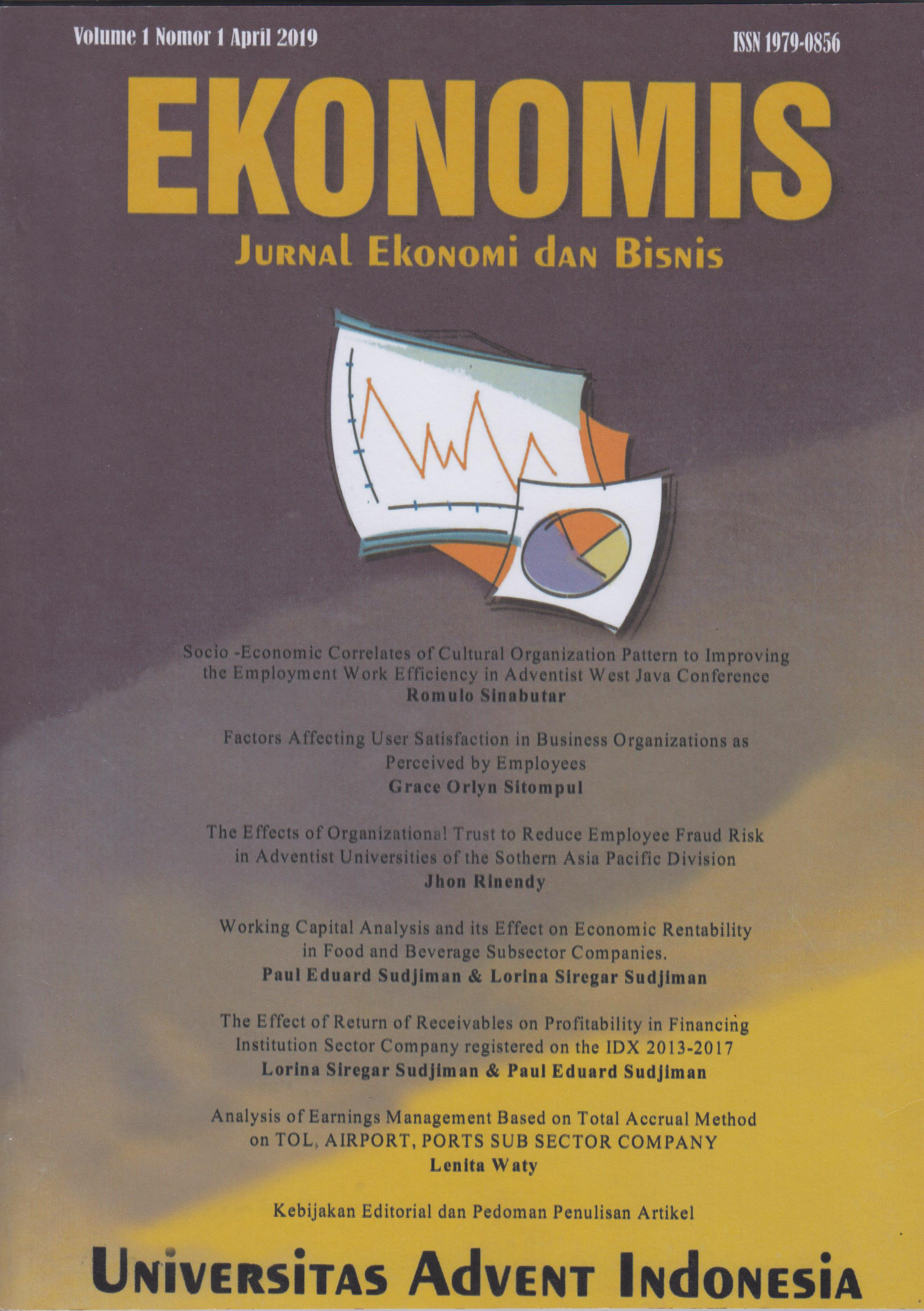THE EFFECTS OF ORGANIZATIONAL TRUST TO REDUCE EMPLOYEE FRAUD RISK IN ADVENTIST UNIVERSITY OF THE SOUTHERN ASIA PACIFIC DIVISION
Keywords:
rationalization, opportunity, pressure, EFR, identification, reliability, concern for employees, honesty, openness, competence, OTAbstract
This study aimed to examine the effects of organizational trust (OT) contributed to reduce employee fraud risk (EFR) in SDA tertiary school within the Southern Asia Pacific (SSD) operational region. EFR could be predicted by component behaviors of OT dimensions (competence, openness, honesty, concern for employees, reliability, and identification) as perceived to prevent and reduce fraudulent acts in relation to misappropriation of assets. The survey research design was employed in this study with convenience random sampling technique. The descriptive-correlational design and multiple regression analysis were used to determine the existing relationship among the variables and the predictors of EFR. The respondents were 407 regular full-time employees of four SDA universities: AIU, AUP, UNAI and UNKLAB. There were three elements must be present for employee to commit fraud base on fraud triangle theory. The findings revealed that “pressure” ranked first as a risk, followed by “opportunities” and “rationalizations.” There was a negative and significant relationship between OT and EFR of the respondents’ perception. Reliability, honesty, competence, dimensions could be predicted to reduce EFR. The results indicate the importance of well-structured organizational trust culture, effective internal controls against employee fraud risk regarding misappropriation of assets by employees.
References
Albrecht, W. S., Albrecht, C. C., Albrecht, C. O., & Zimbelman, M. (2009). Fraud examination. (3rd Ed.). USA: South-Western Cengage Learning.
Brown, A. (2009). Why fraud happens: and what to do about it. Accountancy Ireland:Dublin, 41(1), 30-31. Retrieved from http://www.aiias.edu:2225/ docview/223127495/134B53D9FC366B6801/1? accounted=42729
Callaway, P. L. (2006). The relationship between organizational trust and job satisfaction: an analysis in the U.S. federal work force. (Ph.D. dissertation, Capella University). Retrieved from http://books.google.com/books
CPA Australia. (2011). Employee fraud: a guide to reducing the risk of employee fraud and what to do after a fraud is detected. Retrieved from: http://www.cpaaustralia.com.au/cps/rde/xbcr/cpa-site/Employee-fraud-guide.pdf
General Conference Auditing Service. (2009). Annual Report. Silver Spring, Maryland, USA. Retrieved from: www.gcasconnect.org
Hassan, M., & Semerciöz, F. (2010). Trust in personal and impersonal forms its antecedents and consequences: A conceptual analysis within organizational context. International Journal of Management and Information Systems, 14(2), 67-83. Retrieved from http://search.proquest.com/docview/ 365832653? accounted=42729
Lafleche, D., Elzinga, D., & Seeto, R. (2010) Trust and occupational fraud, Canada: Granth Thorton. Retrieved from http://www.grantthornton.ca/resources/insights/white_papers/Trust_and _occupational_fraud_2010_electronic.pdf
Lodico, M. G., Spaulding, D. T., & Voegtle, K. H. (2010). Methods in Educational Research: From Theory to Practice, 2nd Edition. San Francisco, CA: Jossey-Bass. Retrieved from http://books.google .com/
Pickett, K. H. S. (2010). The internal auditing handbook, (3rd Ed.). UK: John Wiley & Sons Ltd
Ramamoorti, S. & Olsen, W. (2007, July). FRAUD: The Human Factor. Financial Executive, 23(6), 53-55. from ABI/INFORM Global. (Document ID: 1329574871)
Schyns, B. & Hansbrough, T. (2010). When leadership goes wrong: destructive leadership, mistake, and ethical failures, IAP-Information Age Publishing, Inc. retrieved from: http://books.google.com/books
Shockley-Zalabak, P. S., Ellis, K., Cesaria, R. (2000). Measuring organizational trust. International Association of Business Communicators. Retrieved from http://www.iabc.com
Shockley-Zalabak, P. S., Morreale, S. P., & Hackman, M. Z. (2010). Building the high-trust organization. SanFrancisco, CA: John Wiley & Sons, Inc.
Singleton, T. W. & Singleton, A. J. (2010). Fraud auditing and forensic accounting: new tools and techniques (4th Ed.). Hoboken, New Jersey: John Wiley & Sons, Inc.
Tanner, B. (2007). An analysis of the relationships among job satisfaction, organizational trust, and organizational commitment in an acute care hospital. Ph.D. dissertation, Saybrook Graduate School and Research Center, United States -- California. Retrieved from ABI/INFORM Global.
Thornton, S. (2011). What is job security? Retrieve from http://www.ehow.com/about _5470562_ job-security.html#ixzz1f6ExjNzf
Vasile, Thomas H. (2004). Managing business fraud and unethical behavior. M.A. dissertation, State University of New York Empire State College, United States -- New York. Retrieved from ABI/INFORM Global. (Publication No. AAT 1421602)
Wang, Y. & Kleiner, B. H. (2005). Defining employee dishonesty. Management Research News, 28 (2/3). Retrieve January 22, 2012, from ABI/INFORM Global.
Wells, J. T. (2001). Why employees commit fraud. Journal of Accountancy, 191(2), 89-91. from http://www.acfe.com/resources/ view.asp? Article ID =41 ABI/INFORM Global. (Document ID: 67508096)."






